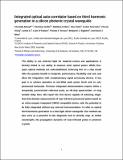Files in this item
Integrated optical auto-correlator based on third-harmonic generation in a silicon photonic crystal waveguide
Item metadata
| dc.contributor.author | Monat, Christelle | |
| dc.contributor.author | Grillet, Christian | |
| dc.contributor.author | Collins, Matthew | |
| dc.contributor.author | Clark, Alex | |
| dc.contributor.author | Schroeder, Jochen | |
| dc.contributor.author | Xiong, Chunle | |
| dc.contributor.author | Li, Juntao | |
| dc.contributor.author | O'Faolain, Liam | |
| dc.contributor.author | Krauss, Thomas F. | |
| dc.contributor.author | Eggleton, Benjamin J. | |
| dc.contributor.author | Moss, David J. | |
| dc.date.accessioned | 2014-09-22T16:01:01Z | |
| dc.date.available | 2014-09-22T16:01:01Z | |
| dc.date.issued | 2014-02-05 | |
| dc.identifier | 150343946 | |
| dc.identifier | 26fb7c8e-594e-47bb-a6c7-fadf37c674d6 | |
| dc.identifier | 000332666700004 | |
| dc.identifier | 84893865199 | |
| dc.identifier | 000332666700004 | |
| dc.identifier.citation | Monat , C , Grillet , C , Collins , M , Clark , A , Schroeder , J , Xiong , C , Li , J , O'Faolain , L , Krauss , T F , Eggleton , B J & Moss , D J 2014 , ' Integrated optical auto-correlator based on third-harmonic generation in a silicon photonic crystal waveguide ' , Nature Communications , vol. 5 , 3246 . https://doi.org/10.1038/ncomms4246 | en |
| dc.identifier.issn | 2041-1723 | |
| dc.identifier.uri | https://hdl.handle.net/10023/5470 | |
| dc.description | We acknowledge the financial support of the European Commission through the Marie Curie program (FP7, ALLOPTICS), as well as the Faculty of Science at the University of Sydney and the Australian Research Council (ARC) through the Centre of Excellence (CUDOS), Discovery project (DP110100003) and DECRA programs (DE120100226, DE120101329, DE130101148). J.L. was supported by the grant of NKBRSF (G2010CB923200), NNSFC (11204386) and GNSF (S2012040007812). | en |
| dc.description.abstract | The ability to use coherent light for material science and applications is linked to our ability to measure short optical pulses. While free-space optical methods are well established, achieving this on a chip would offer the greatest benefit in footprint, performance and cost, and allow the integration with complementary signal-processing devices. A key goal is to achieve operation at sub-watt peak power levels and on sub-picosecond timescales. Previous integrated demonstrations require either a temporally synchronized reference pulse, an off-chip spectrometer or long tunable delay lines. Here we report a device capable of achieving single-shot time-domain measurements of near-infrared picosecond pulses based on an ultra-compact integrated CMOS-compatible device, which could operate without any external instrumentation. It relies on optical third-harmonic generation in a slow-light silicon waveguide. Our method can also serve as an in situ diagnostic tool to map, at visible wavelengths, the propagation dynamics of near-infrared pulses in photonic crystals. | |
| dc.format.extent | 8 | |
| dc.format.extent | 1090231 | |
| dc.language.iso | eng | |
| dc.relation.ispartof | Nature Communications | en |
| dc.subject | Band slow light | en |
| dc.subject | Parametric gain | en |
| dc.subject | Fourier optics | en |
| dc.subject | CHIP | en |
| dc.subject | Dispersion | en |
| dc.subject | Pulses | en |
| dc.subject | Wavelength | en |
| dc.subject | Nanowire | en |
| dc.subject | QC Physics | en |
| dc.subject | QB Astronomy | en |
| dc.subject | BDC | en |
| dc.subject.lcc | QC | en |
| dc.subject.lcc | QB | en |
| dc.title | Integrated optical auto-correlator based on third-harmonic generation in a silicon photonic crystal waveguide | en |
| dc.type | Journal article | en |
| dc.contributor.sponsor | EPSRC | en |
| dc.contributor.institution | University of St Andrews. School of Physics and Astronomy | en |
| dc.contributor.institution | University of St Andrews. Microphotonics and Photonic Crystals Group | en |
| dc.identifier.doi | 10.1038/ncomms4246 | |
| dc.description.status | Peer reviewed | en |
| dc.identifier.grantnumber | EP/F001622/1 | en |
This item appears in the following Collection(s)
Items in the St Andrews Research Repository are protected by copyright, with all rights reserved, unless otherwise indicated.

